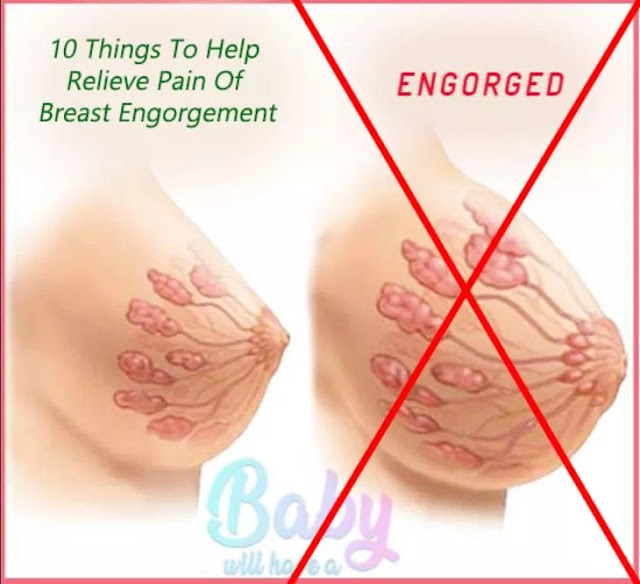10 Things To Help Relieve Pain Of Breast Engorgement
Normally a few days after giving birth, you will notice changes in your breasts. They will become bigger, somewhat hard, and slightly soft as they start to make more milk. This is breast engorgement. Breast engorgement is very normal and there is nothing to worry about. However, breast engorgement may makes it hard for your baby to get the milk. Your baby might not have the ability to attach himself on properly and your breasts might get swollen. If your baby is having problems getting milk, the pressure because of breast engorgement can make you make less milk or even stop making milk altogether. Knowing how to deal with breast engorgement should be very helpful for you to avoid this inconvenience.

Luckily, there are 10 things you can do to relieve breast engorgement.
1- Nurse often
Feeding your baby milk from your breasts often could make your breasts less engorged. Plan to feed your baby at least every 2 to 3 hours until you have less engorgement. Feeding less during the night is acceptable. You can keep a 4 to 5 hours period between feedings during the night, but don't go that much between feedings more than one time daily in the first month. Keep in mind that you need to feed your baby 8 to 12 times a day. Your baby should have milk at least 10 minutes on the first breast before moving to the second one.2- Use heat and cold to lessen discomfort
Warm your breast exactly before feeding your baby. Heat makes blood flow better. Take a warm bath before feeding or cover your breasts with a warm cloth. Cold things such as frozen vegetable bags after breastfeeding might decrease the swelling.3- Massaging your breasts while nursing
As long as you are nursing your baby keep stroking your breasts with your fingertips to make the milk flow better, thus relieving your breast engorgement.
4- Use reverse softening
The reverse pressure softening method uses soft pressure to soften the area surrounding the nipple. This helps move some of the swellings around the nipple so that the baby can attach himself more deeply into the breast. It could help you to lay flat to allow gravity to locate the swelling elsewhere. Put the fingertips of both of your hands down your nipple and gently press in the direction of your chest. The pressure must be tough but not painful.
Once the area around your nipples is gentle, you can more easily let out milk. Before each feeding, use your hands to let out a small amount of milk from your breasts. Express enough milk to soften the nipple and the area around it so that your baby can better hold the area around the nipple. Softly massage your breasts before and during nursing to help empty your breasts and soften them.
It’s important to be able to empty your breasts and end swelling because engorgement puts pressure on the glands that make milk and can quickly decrease your supply of milk. If your breasts are so full that your baby cannot latch on or if your baby is not feeding properly after your milk has come in immediately, you might need to use a breast pump. If your baby is not nursing well, pumping your breasts will let you relieve discomfort and keep your breasts making much milk.
Once the area around your nipples is gentle, you can more easily let out milk. Before each feeding, use your hands to let out a small amount of milk from your breasts. Express enough milk to soften the nipple and the area around it so that your baby can better hold the area around the nipple. Softly massage your breasts before and during nursing to help empty your breasts and soften them.
Read Also What is the condition of breast engorgement?
5- Express or pump milk as needed
Many women don't like pumping or hand expressing milk while they are engorged because they fell it will cause them to make even more milk. However, breast engorgement is a problem of not so good milk flow, and it is not a problem of too much milk.It’s important to be able to empty your breasts and end swelling because engorgement puts pressure on the glands that make milk and can quickly decrease your supply of milk. If your breasts are so full that your baby cannot latch on or if your baby is not feeding properly after your milk has come in immediately, you might need to use a breast pump. If your baby is not nursing well, pumping your breasts will let you relieve discomfort and keep your breasts making much milk.
there are 10 things you can do to relieve breast engorgement.
6- Pump more milk
If your breasts are still uncomfortably swollen after feeding your baby, pump milk for a few minutes until your breasts are not hard and you have less discomfort. Soon your baby will feed from your breasts well at each feeding and you will not need to express. If it is not needed, the milk you express can be put in the fridge for use in the future.7- Aim to be comfortable while breastfeeding
When you have enough experience with nursing, you should learn how to get your baby latched on well so that you feel the least pain possible in the process.8- Alternating feeding positions
Do this to empty the milk from all areas of the breast. You should keep in mind the best position for your baby.
9- Medication
If you are feeding your baby with formula and not breast milk, uncomfortable breast engorgement will normally get better after 3 to 4 days of not nursing your baby. During this time, wear a comfortable bra. Ice packs put on the breasts for short periods of time will supply relief. Also, you might take ibuprofen to relieve the pain.10- Wean slowly
If you’re too fast to stop feeding your breast milk to your baby, your weaning plan may have the opposite wanted results. You can end up with too much milk. Carefully wean your child so your breasts can get used to the decreased need.





